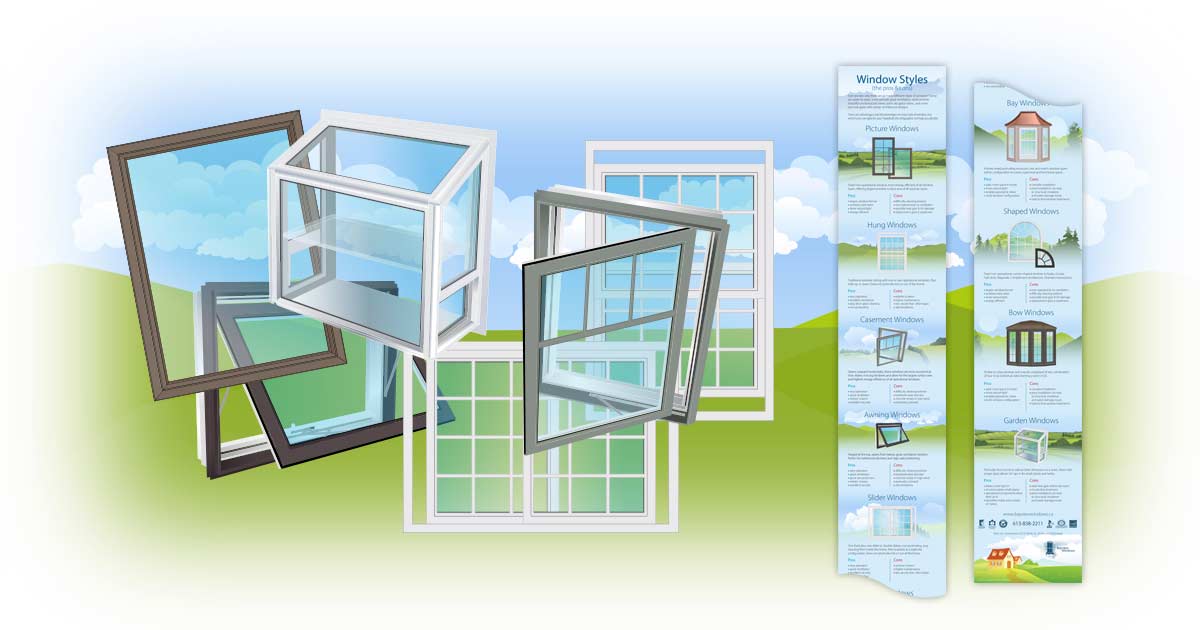Insights > Article > Posted: 2023-Nov-16, Updated: 2025-Dec-24
Bay and Bow Windows for Ottawa Houses: Benefits, Differences & Installation Tips
In this article:
There are plenty of styles, features, benefits, and options to choose from, but which ones are right for you? This article will help you decide. Technically bay and bow windows aren’t windows at all; they are an arrangement of several windows that together make a whole. Found in both new and older homes, both types of these windows will add elegance to any room. So, if you are looking for visual drama in your home, perhaps you might want to consider installing a bay or bow window.
Bay Windows
Bay window characteristics
A Bay window protrudes out of a home and is comprised of three distinct sides. The front typically includes a single fixed window (can also be an operable window), and two sides called flankers (angled from the wall at a 30 or 40-degree angle) which can include fixed, hung, or casement windows.
Custom bay windows can be made to fit the size of an existing window; however, a bay window will typically be at least 40 inches wide. They can stretch from floor to ceiling or can start at knee or waist height. The outward projection can extend out a single foot, or several feet. From an interior perspective, a bay window will create a large or small alcove. Bay windows are a great way to create a feeling of spaciousness in any room.
Operable flanking windows provide excellent ventilation as they can catch airflow at different angles to increase the flow of air into the home.
With multiple bay window styles and configurations available, you can build a custom bay window to fit the unique characteristics of your home’s architectural style.
Typical bay window styles
- Canted Bay Window: Canted bay windows have the classic shape you expect to see in a bay window. They have a flat front with angled sides (30 or 40 degrees) and are made for the first floor of homes.
- Box Bay Window: Box bay windows are structurally similar to canted windows, however, the flanking sides meet the front at a 90-degree angle rather than 30 to 40 degrees, thus creating the shape of a box.
- Circle Bay Windows: Curved bay windows are rarely used in today’s residential construction. They are built around a circular footprint with window glass that can be curved or flat. Because of their complex nature, curved bay windows are significantly more expensive than other flat-walled bay window solutions.
Common bay window roof styles
A typical bay window will have a three-sided roof (also called a hip roof) that can be finished with shingles, metal, or copper. The roof can be curved from the top down, or in very rare cases cone-shaped to fit a curved bay window. Other custom roofing styles that will accommodate the architecture of a home (dormers, soffits) are possible.
If you are looking for something that may not fit the more standard roofing practices, be sure to consult with your window expert; there are plenty of custom solutions available.
Some of the more typical styles of bay window roofs are shown below.
Bay window operable window options
The most common types of operable windows available for bay windows include casement or hung/double-hung windows however combinations that include awning windows are also possible. Sliding windows are very rarely used.
- Casement windows: Casement windows allow you to open the entire window panel to maximize ventilation with the turn of a crank. However, because casement windows open out into outdoor living spaces they may not be appropriate.
- Single-hung/double-hung windows: Hung windows tend to be the preferred choice for operational windows on bay windows. The single-hung window option opens only the bottom half of a window, while the double-hung window presents a choice of opening the window from the top, bottom, or both sashes to maximize air circulation.
- Awning windows: Although awning windows are not typically used on bay windows, in combination with other windows, they do offer a great ventilation solution, especially in rainy geographical regions. Be sure to talk to your window consultant if you think you might want to install an awning window as a part of your bay window.
Bay rather than bow: A bay window protrudes further out of a house than a bow window; they are less expensive, easier to install and offer more design and function options than a bow window. However, a bay window will require more structural support than a bow.
Bow Windows
Bow window characteristics
Bow windows create space by projecting beyond the exterior wall of a home to provide a wide view of an outside yard, garden, or street. They are typically made up of four or more windows, which join together to form an arch. The minimum width of a bow window is typically about 80 inches.
A bow window has an elegant look with more gradual curves (windows are all the same size) rather than sharper angles. The wider the bow window, the more interior space it will create.
Although it is common for bow windows to be made up of fixed non-operable windows, many manufacturers offer operational windows as an option. The most common configuration of a bow window is an arching row of five windows.
Bow window styles
Bow windows only come in one style; however, depending on the window space and the number of windows, they can look very different from one bow window to another.
Bow window roofs
As with bay windows, bow roofs can be finished with shingles, metal, or copper. Bow roofs can be cone-shaped, circular, flat, or trussed; they can be incorporated into a soffit or overhanging roof. Be sure to talk to your window consultant to discuss the best options for your new bow window roof.
Bow rather than a bay window
A bow window will typically protrude less than a bay window; however, with more windows, a bow window will allow more light into a home. Because bow windows are usually made up of more than 4 windows, they will cost more than a bay window.
Insulating Bay and Bow Windows
Because a bay and bow window protrude out from the house, special care must be taken to make sure that the roof and bottom of the window structure are properly insulated. Professional installation will ensure that the window is properly installed and insulated to regional building codes.
Installation
Although some manufacturers build standard Bay and bow configurations, typically these windows will require a custom building solution. Whether you are looking to renovate an existing window or add a new one from scratch, there is a lot to consider. A professional bay and bow window installer knows how to remove old windows and replace them efficiently. They’ll understand what’s required to integrate into a wall or build into an existing room and they understand what’s required within regional building codes.
Most bay and bow windows are installed in the initial construction of a home. This ensures that the built-in double joists (and cantilevering) will provide proper support and that rafters are tied into the framing of the home.
When replacing a flush window with a bay or bow window special supports will need to be incorporated. This may include hidden cables (inside the window component), knee braces or brackets.
Bay and bow windows can be flush with a floor and built into the foundation of a house or they can be cantilevered (supported by extended joists or by cables which are hidden in the window structure) hanging out from the wall.
Proper installation is a must, if done improperly, heat can leak out in the winter, cold air can leak out in the summer or water can get in and cause damage to your home, or mould problems.
When installed improperly, bay windows can develop structural issues over time. That’s why it’s vital to have them installed by a professional. For best results, be sure to look for a lifetime warranty on labour, materials, and installation.
Summary
Bay windows, with their protruding design and various styles like Canted, Box, and Circle, offer versatility and cost-effectiveness. On the other hand, bow windows, characterized by a graceful arch, allow more light but come at a slightly higher cost. This guide emphasizes the importance of proper insulation, professional installation, and careful consideration of structural support for those considering these windows. Whether flush or cantilevered, bay and bow windows add character and curb appeal to homes, promising a harmonious blend of elegance and functionality.
Related articles
Need more information?
Want to know more about bay and bow windows? Give us a call or send us a request. Better still, schedule an appointment and come in and talk to one of our window associates. We’d be happy to answer all of your questions.


